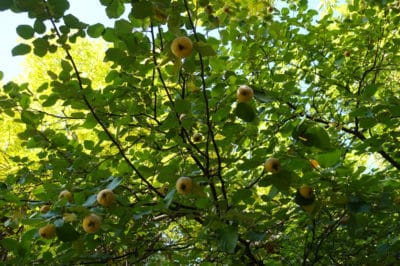Scent the Garden
Love the idea of fruit that wears its own perfume? Then grow your own quince tree (Cydonia oblonga)! Every fall, its ripe, golden-yellow fruit saturates the garden with scents of:
- Coconut
- Pear
- Apple
- Violet
- Guava
and just a hint of musk.
Allowed to ripen indoors, quinces are all-natural air fresheners.
Expert gardeners’ tip: Don’t mistake the quince trees native to southern China for Japanese quince shrubs (Chaenomoles spp.) grown primarily for their lovely red spring flowers.
Where to Grow a Quince Tree
Quince trees are suitable for USDA plant hardiness zones 4 through 9, depending on variety. The most cold hardy ones handle winter temperatures as low as -30°F (-34.4°C). Some readily available choices include:
- ‘Champion,’ zones 4 through 6.
- ‘Orange,’ zones 5 through 8.
- ‘Pineapple,’ ‘Kyucu Red’ and ‘Aromatnaya,’ zones 5 through 9.
Sun and Soil
Cold tolerance aside, quince trees perform best with plenty of sun and warmth. That means at least six hours of daily sun. Where summer is sunny but cool, think about planting your quince as an espalier on a heat-absorbing, south- or west-facing wall.
Quince trees accept a wide range of acidic to alkaline soils, but produce most heavily in organically rich, consistently moist loam. In sandy soil, they benefit from a generous pre-planting addition of organic compost and a 2-to 3-inch layer of moisture-preserving, organic mulch.
Spacing
All quince trees are self pollinating, so you needn’t worry about planting more than one. But for easier pruning and harvesting, allow 10 feet between your tree and its nearest neighbors.
Watering and Fertilizing
In your tree’s first year, water once weekly if it’s; sandy loam or clay and twice weekly if it’s in sand. Water slowly and deeply — 40 to 50 minutes if you’re using a drip system.
From the second year on, give it least 1 inch of water per week, or 6 gallons (22.7 liters) per 10 square feet of soil. In prolonged dry periods, more is advisable. An underwatered quince tree may drop its fruit.
Fertilize your quince according to your growing zone. In zones 4 through 8, fertilize after bud break in spring and again in June. In zone 9, fertilize in late February, late May and early August.
Use an organic, slow-release 5-2-6 fertilizer containing calcium, magnesium and sulfur. Apply:
- 6 cups (.67 liter) for a 1- to 3-foot tree.
- 12 cups (1.34 liters) for a 4- to 6-foot tree.
- 18 cups (2 liters) for a 7- to 9-foot tree.
- 24 cups (2.67 liters) for a tree over 9 feet.
Starting 5 inches from the trunk, scatter the fertilizer evenly to the edges of the canopy and rake or water it into the soil.
